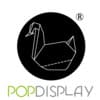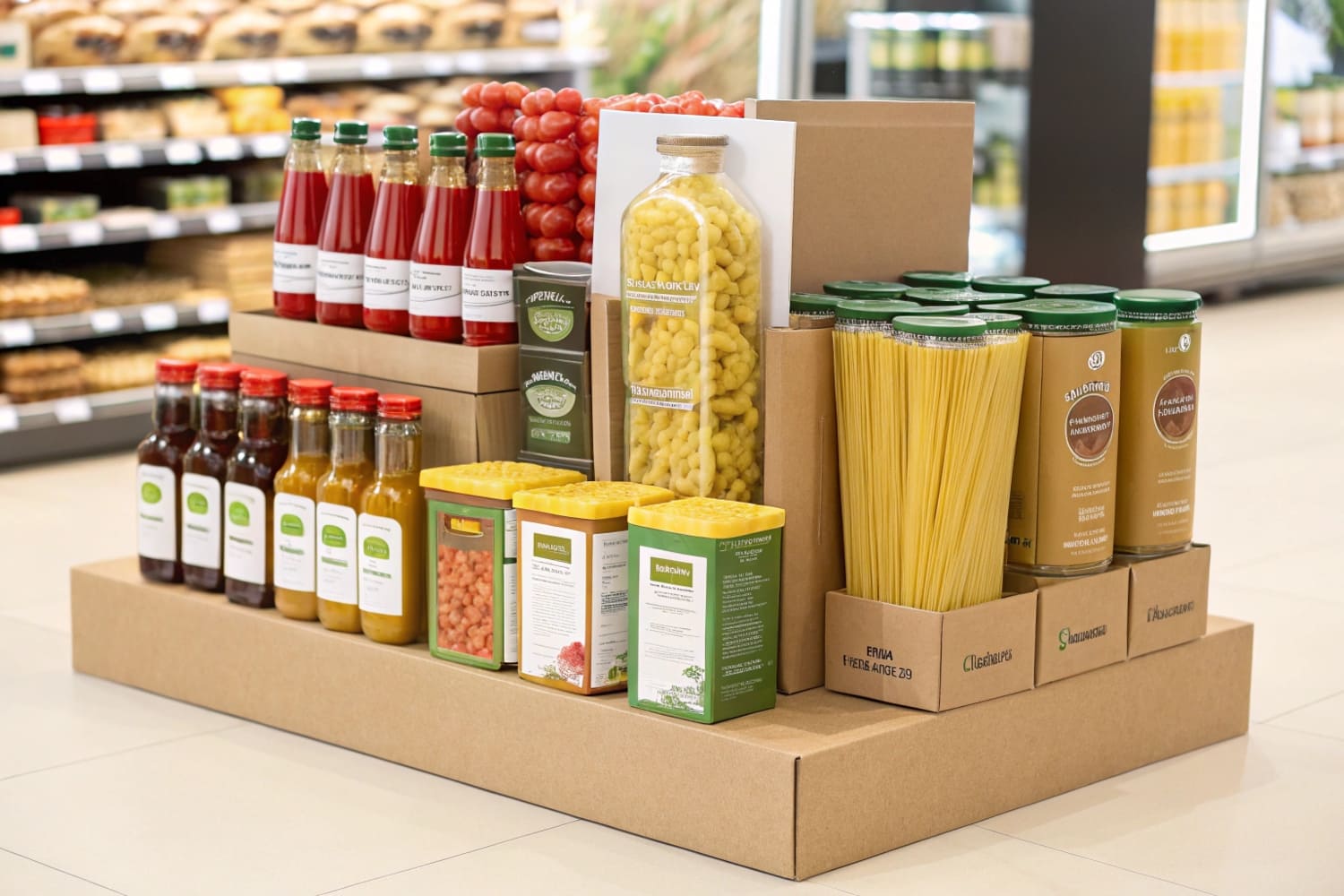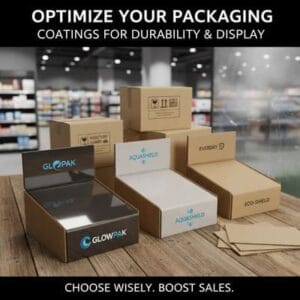Shoppers walk past weak displays. I need baskets to grow now. Cross-merchandising turns quiet space into real sales with simple pairings, smart layouts, and fast, low-cost cardboard builds.
Cross-merchandising places related products together on one display or zone to trigger impulse and bigger baskets; I use affordable cardboard floor, pallet, and counter units, tight adjacencies, simple signs, and data-led pairings to guide quick choices.
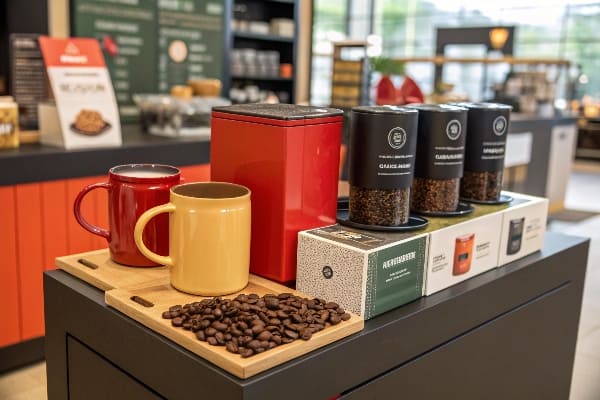
I keep this guide practical. I write from the factory floor and the store aisle. I sell B2B only. I design, test, and ship cardboard displays every week, so my playbook stays real.
What is cross merchandising in retail?
Shoppers do not plan every purchase. I place the right add-on near the hero item. That solves a need and grows the basket.
Cross merchandising is the practice of grouping complementary products to solve a use case in one stop; I plan the pairing by shopper mission, place it in flow, then confirm with sales data.
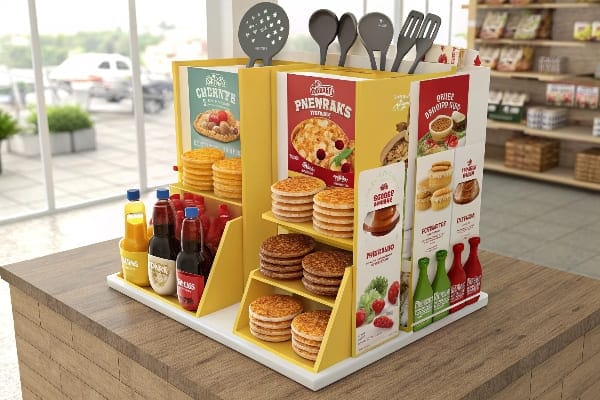
How it works in practice
I start with a need. A hunter buys a crossbow1. He also needs broadheads2, wax, and safety gear. I design one cardboard floor display that holds the bundle. I keep price points clear. I keep instructions simple. I stay near the path to purchase, not hidden in a corner. I test strength, since sharp tools add weight. I print high-contrast branding, because hunting aisles are busy. I use water-based inks and recyclable board, because buyers and retailers ask for it. I plan for fast assembly. Flat-pack saves freight and labor. My team signs off with load tests, then I track the sell-through.
Typical pairings and reasons
| Pairing Type | Example | Why it Works | Best Display |
|---|---|---|---|
| Core + Accessory3 | Crossbow + broadheads | Solves full use case | Floor display |
| Refill Next To Device | Knife + replacement blades | Triggers repeat | Clip strip |
| Occasion Kit4 | Camp stove + fuel | One trip, full set | Pallet display |
| Trial + Trade-up | Entry arrow + pro arrow | Ladder choice | Shelf tray |
How can cross merchandising be demonstrated most effectively?
Managers want proof, not theory. I show fast wins in one bay or one endcap. I keep setup simple. I measure lift.
I demonstrate effectiveness with a single themed display, a clear headline, tight adjacencies, price ladders, before-after sales baselines, and quick shopper interviews; then I scale the winning layout across more stores.
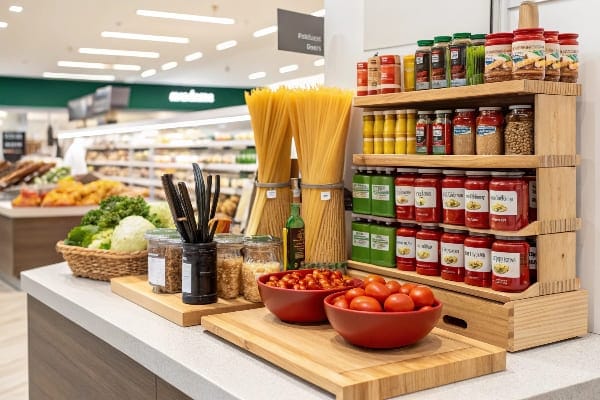
Playbook I use to show results
I pick one high-traffic spot and one clear mission. I use a bold header that names the mission, like "Ready to Hunt." I put the hero on the top shelf or center. I group two to three add-ons by need and price. I mark a good-better-best ladder. I print QR codes for quick setup videos. I tag sustainability5 with simple icons, because many buyers care. I use cardboard floor units because they are fast, light, and cost-effective. In some reports, floor POP displays6 hold the largest share, near 43.7%, so I lean on that format for impact. Digital printing lets me run small pilots without waste. I record a four-week baseline, then four weeks after launch. I measure units per basket and attachment rate. When I worked with a hunting brand last season, I placed wax and safety glasses next to a new bow. Attachment rose by double digits in two weeks.
Pilot checklist and roles
| Step | Owner | Tool | Output |
|---|---|---|---|
| Pick mission | Buyer | POS data | Target SKU list7 |
| Build layout | My design team | 3D + print | Flat-pack files |
| Set up | Store team | Quick guide | 10-minute build |
| Measure | Analyst | POS pull | Lift report8 |
What is the process of merchandising in retail?
Projects fail when steps blur. I keep a simple path. I follow it for every display, from brief to reorder.
The process runs as: brief → insight → design → prototype → strength test → print → ship → set up → measure → optimize; I keep each step short, with clear owners and dates.

The steps I run and why they matter
I start with a short brief. I write the shopper, the mission, and the budget. I pull data on traffic and attachments. I sketch three layouts. I review with the buyer in one call. I build a white sample to test fit. I switch to a full-print sample for color proof. I run load and drop tests, since cardboard must survive freight and busy aisles. I choose board grade by weight and dwell time. Single-wall corrugated9 still covers most retail needs, so I use it unless the product is heavy. I print with water-based inks10 for clean color. I plan kitting and labels for easy store setup. I ship flat to save cost. I track sell-through weekly. I tweak pegs, shelves, or copy if lift stalls. I scale to pallets for clubs like Costco. I reuse art to save time.
My standard workflow
| Stage | Key Question | Decision Gate | Risk Control |
|---|---|---|---|
| Brief | Who buys and why? | Buyer sign-off11 | Budget lock |
| Design | What holds and shows best? | CAD + 3D ok | Dieline audit |
| Sample | Does it fit and match color? | Sample ok | Color swatch |
| Test | Will it survive? | Load pass12 | ISTA-style check |
| Print & Pack | Can stores build fast? | Kitting ok | QR guide |
| Track | Did baskets grow? | Lift ≥ target | Swap layout |
What display techniques are used in visual merchandising?
Shoppers notice order and color. I use simple visual rules. These rules keep choices clear and speed the grab.
I use color blocking, vertical blocks, rule of three, price ladders, pyramid composition, clear hero zones, eye-level adjacencies, and PDQ trays; I add QR codes, sustainability icons, and simple wayfinding to cut friction.
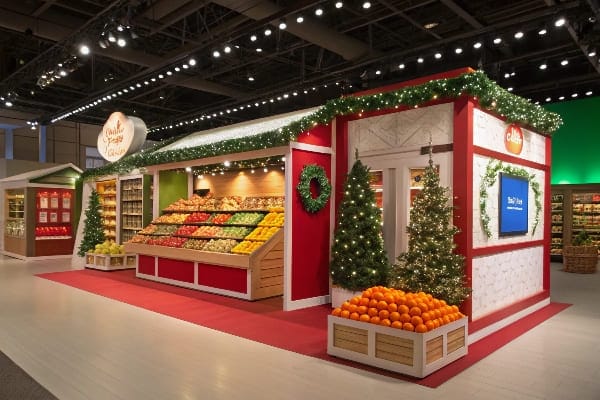
Techniques I rely on and when to choose them
I keep the set clean. I use one color family per story. I stack vertical to help scanning. I group in threes to reduce choice stress. I build a pyramid: strong base, clear hero at the apex. I show a price ladder13 from entry to pro. I keep hands-on where safe. I add a short benefit line, not a paragraph. I place heavy items low for safety. I use PDQ trays near checkout to win impulse. I add nano-coated board when moisture is a risk. I mark FSC or recycle icons when the retailer asks. I use AR or short video codes when a product needs a quick demo. I print on demand with digital presses to meet tight launches. I avoid gloss if lighting glares. I keep copy in plain words. I measure with heat maps14 or simple observation.
Technique menu
| Technique | Use Case | Tip | Display Type |
|---|---|---|---|
| Color blocking15 | Many SKUs | One palette | Shelf tray |
| Vertical block | Fast scan | Repeat labels | Floor unit |
| Rule of three16 | Choice edit | Good-Better-Best | Countertop |
| Pyramid | Hero focus | Big top sign | Pallet |
| Price ladder | Trade-up | Clear steps | Endcap |
| PDQ near POS | Impulse | Small packs | PDQ tray |
| AR/QR help | Complex item | 10-sec video | Floor unit |
How can stores communicate effectively with customers through merchandising and displays?
People want quick help, not clutter. I let the display speak in short words and clear signs. I answer the next question before it is asked.
I communicate with one headline, one image, three benefits, a simple price ladder, clear sustainability icons, and a QR for setup or safety; I place the message at eye level and repeat it at hand level.

Message map I use in the aisle
I write like I speak. I avoid jargon. I keep the headline on one line. For a hunting set, I use "Ready to Hunt." I show the crossbow, the broadheads, the wax, and the glasses. I state three benefits: safer, faster, cleaner shots17. I add a QR code that opens a 30-second setup clip. I include a small panel that says "100% recyclable board, water-based inks18." Many buyers like that. For the Barnett-style buyer, deadlines are strict. My Shenzhen team runs three lines, so I can hit rush orders. I once caught a color drift before ship. I fixed the profile and reprinted overnight. I add a tamper-safe strap if the blades are heavy. I mark certifications cleanly. I print the load rating near the peg. I offer simple payment and tracked freight. I send a one-page assembly guide with big pictures.
Message building blocks
| Block | Purpose | Best Practice | Proof |
|---|---|---|---|
| Headline | Stop | One line, big type | "Ready to Hunt" |
| Visual | Show | Product in use | Lifestyle photo |
| Three benefits19 | Convince | Action verbs | "Steady. Fast. Safe." |
| Price ladder20 | Decide | Clear steps | Entry → Pro |
| Icons | Reassure | Recycle, FSC, QR | On base panel |
| Help link | Support | 30-sec video | QR scan stats |
Conclusion
Cross-merchandising works when I solve a need in one place. I pair smart. I design fast. I test strength. I measure lift. I scale what wins.
Explore this link to discover essential crossbow accessories that enhance your hunting experience and ensure safety. ↩
This resource will guide you in selecting the perfect broadheads, crucial for effective and ethical hunting. ↩
Discover how core and accessory pairings can enhance customer satisfaction and drive sales. ↩
Learn about occasion kits and how they provide convenience and value for specific events. ↩
Explore this link to discover effective strategies for highlighting sustainability, which resonates with eco-conscious consumers. ↩
Learn about the advantages of floor POP displays, which can significantly enhance product visibility and sales. ↩
Understanding the Target SKU list is crucial for effective inventory management and sales strategies. ↩
A lift report provides insights into sales performance, helping businesses make informed decisions. ↩
Explore this link to understand why single-wall corrugated is a popular choice for retail packaging, balancing cost and durability. ↩
Discover the benefits of water-based inks, including environmental impact and print quality, to enhance your packaging strategy. ↩
Understanding buyer sign-off is crucial for ensuring project alignment and securing necessary approvals. ↩
Learn about load pass criteria to ensure product durability and reliability in real-world conditions. ↩
Understanding price ladders can enhance your pricing strategy, helping you attract different customer segments effectively. ↩
Exploring heat maps can provide insights into customer behavior, optimizing your store layout for better sales. ↩
Explore this link to understand how color blocking can enhance product visibility and attract customers effectively. ↩
Discover the power of the rule of three in merchandising to create appealing displays that guide customer choices. ↩
Discover how these benefits enhance your hunting experience and improve your performance. ↩
Learn about sustainable packaging practices and their impact on the environment. ↩
Explore this link to learn how to craft compelling product benefits that drive customer action. ↩
Discover strategies for designing a price ladder that helps customers make informed purchasing decisions. ↩
